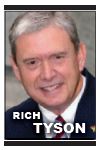Richard Tyson
In the wee hours of the morning of Feb. 20, 1978, my bedside telephone jolted me out of a deep sleep. When I answered, I immediately recognized the voice on the line. It was my father-in-law. His news was alarming — my wife’s grandmother had died unexpectedly a few hours earlier. The conversation was short, leaving me with the immediate task of sharing the sad news with my wife.{mprestriction ids="1,3"}
The next morning, we began planning to drive from our home in southern California to northern Utah for the funeral that would soon be scheduled. At work, I shared our plans with my boss. He expressed his condolences and assured me that I could take time off when funeral arrangements firmed up.
Back at home that night, I was again roused from sleep by the ringing telephone. This time, the voice on the line was my wife’s mother. Her emotions were easily discernible as she shared that her husband, my wife’s father, had succumbed to a massive heart attack earlier that evening. The impact of this was devastating, to say the least.
The next day at work, I shared this development with my boss, emphasizing again that I would need to drive to Utah, now for two funerals. His response took me by surprise. He said, “No, you will not drive to Utah in the middle of the winter, especially when your emotions are so unsettled.”
My first reaction was to stand my ground. I let him know, in no uncertain terms, that we would not be missing the funerals, to which he asserted that we should fly rather than drive. I reminded him that I had a family of four, my wife and I, and two small children. I simply couldn’t afford the cost of airfare for all of us.
That’s where the conversation ended, at least for a few days. However, once funeral arrangements were made, I let my boss know when we would be leaving. Later that same day, he walked into my office with an envelope in hand. He slid it across my desk, saying “You will not be driving to Utah.”
Inside the envelope were four round-trip airline tickets for Salt Lake City. I was stunned! When I caught my breath, however. I protested, “I can’t let you pay for us to fly!” He responded firmly, “You don’t get to make that decision. Go to the funerals, be there for your family and don’t think about work until you return.”
We went to the funerals, of course, and safely returned to Los Angeles thereafter. As much as we experienced the sadness of our family’s losses, we were also overwhelmed by the kindness and compassion of my boss. This experience, which happened over 40 years ago, has since stood as an example of a leader who put his people first. To this day, I am grateful for my boss, Bob Vanourek.
In my subsequent career of leadership coaching, I developed a model for highly effective interpersonal leadership largely based on Bob. I share it in the form of an acronym, PACER:
• P: People. You recognize and appreciate that people are your most important asset and therefore are your highest priority responsibility.
• A: Awareness. You strive to be continuously aware of the challenges, opportunities and situations faced by your people. This is not just at work; it acknowledges that each person has a life outside of their job that is important to them. True awareness requires both observation of others — and discernment of their aspirations and concerns.
• C: Communication. You master the twin arts of asking good questions and listening intently. As your people recognize these attributes in you, they will become increasingly open in sharing their thoughts. Good questioning and intense listening are the keys that open the door to strong two-way communication.
• E: Empathy. Your responses and reactions to what is shared show genuine interest, caring and compassion. This needn’t be overly emotional, but it must be real, reflecting unfeigned concern.
• R: Respect. Relationships build to high levels of mutual respect and trust. This doesn’t happen overnight, but as you consistently live the principles of the Interpersonal PACER Model, a positive transformative effect will emerge in the culture of your organization.
Leaders like Bob Vanourek have demonstrated what authors Rasmus Hougaard and Jacqueline Carter have called “wise compassion” in their book Compassionate Leadership.
They assert that leaders who master these behaviors balance compassion with the wisdom of high expectations. These expectations include strong engagement, hard work and excellent performance. They do hard things in human ways. This is an especially apt description of my friend Bob Vanourek.
Richard Tyson is the founder, principal owner and president of CEObuilder, which provides forums for consulting and coaching to executives in small businesses.{/mprestriction}








